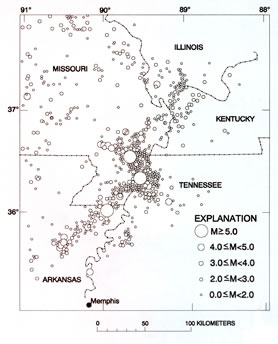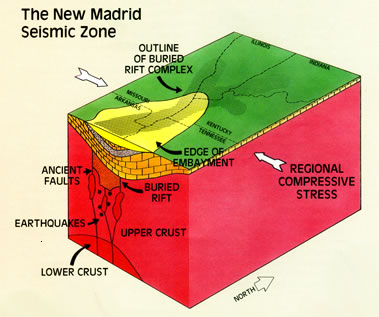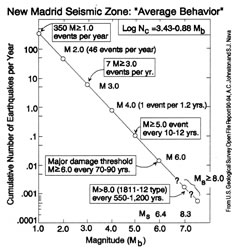The new Madrid Seismic Zone (NMSZ) is one of the rocky, mountainous regions in the eastern parts of United States. The NMSZ occupies the southeastern part of Missouri and the southern part of Illinois. The large earthquakes, which occur in the region significantly, affect the New Madrid Seismic Zone.
The closest areas that are also affected by the zone earthquakes are Arkansas, Tennessee, Kentucky, and Illinois (Weznger 213). The southwestern parts of Indiana and the northwestern Mississippi have also declared to receive extraordinary shaking from the regions strong earthquakes.
Interesting physical features such as Rocky Mountains, rivers, and natural phenomenon like earthquakes surround the area. The latest New Madrid fault system covers an area of 120 miles, cutting across the Mississippi River as well as Ohio River.

The above figure shows the neighboring areas that are also affected by earthquakes (Nixon 1).
Geology
The New Madrid Seismic Zone is composed of faults that were experienced, when the area that is currently referred to as North America broke up. This occurrence happened nearly 750 million years ago. The main cracks, which were formed, resulted to present faults that are found in the zone.
The magma that was pushed from inside the rocks came at the surface and formed themselves into igneous rocks (Keith and Petley 134). The rift, that was formed when the earth was splitting off, remained as a region of weakness underneath the earth surface. Later, yet another unsuccessful rifting trial left the area being weaker than before, therefore, creating more faults.
The second occurrence of unsuccessful rifting occurred approximately 200 million years ago. The reel foot rift was realized because of geological structures that emerged after every rifting attempt. The large rocks that are found underneath the earths surface in New Madrid are feared to be mechanically weaker than most of other parts of North America, due to the past fault that were created.

The above figure (Nixon 1).
The underneath weaknesses, together with the effects of stronger rocks, allow the east west condensed forces to reinforce the old faults. Although there are several rifts that are experienced in most parts of North America, not all of them are associated with the modern types of earthquakes that occur in the area (Nixon 1).
For instance, the mid-continent rift system that starts from Minnesota and ends in Kansas may not be associated with any earthquake, as other processes may add to mechanical stress on the already existing faults.
Some of the local processes that are suspected to cause earthquakes are downward pulling from underneath rocks that are below the fault. Other incidences include bending of the lithosphere because of continental glaciers melting.
Several suggestions are made concerning the heating that happen in the lithosphere, may result in making the big rocks inside more plastic. This heating may cause the concentration of compression force in the shallow underneath regions, where the faulting happens (Keith and Petley 98).
There is also a model that describes local stress to happen because of a change in the passage of the mantle below the New Madrid Seismic Zone, due to sinking Carillon Plate. There are three types of trends realized when epicenters of modern earthquakes are presented in the form of a map.
The first system of a trend is referred to as general northeast southwest. This trend is parallel to the drift of the Reel foot Rift in part of Arkansas. The second system of the trend is called southeast to northwest. This drift is experienced at the southwest part of New Madrid. The third system of a trend is known as northeast to northwestern. It extends to the farthest end of the Reel foot Fault.
Earthquakes
The New Madrid Seismic Zone recorded four of the largest earthquakes that have happened in North America. They were big earthquakes estimated to be as large as 8.0. The largest earthquakes that were first experienced in this zone occurred between 1811 and 1812(Keith and Petley 107).
The New Madrid Sequence is the overall effects of all the earthquakes that happened during that period. It has been always a challenge to measure the effect of one earthquake. The magnitude approximates and epicenters are based on the results of historical records, and this may vary from one period to the other.
Earthquakes in the past or the recent ones that have happened for the last 10000 years have been caused by faults, which are not always micro seismically active. According to some of the researches done, it is evident that quiet faults are at times dangerous than the active ones (Keith and Petley 114).
High built up stress blocks both sides of the fault, hence hindering the occurrence of micro seismic earthquakes. This process happens before the major rupture of the fault happens; investigations are still ongoing to define whether such types of faults do happen in New Madrid Seismic Zone.
Further investigations are required to proof, as it would be hard to locate such incidences. For the last 10000 years, people in this zone felt more than two thousand quakes. Crude seismograph instruments were used to detect these quakes, and most journalists managed to record these events in personal journals (Weznger 237).
In the central United States, rocks that are found there are hard, cold, and dry. The presence of such rocks makes earthquake in this region to be strong than the earthquakes that happen in California as well as in other areas. The earthquakes, which happen within the New Madrid Seismic Zone, cause damages, which are approximately 20 times larger than in other areas.

The above figure (Nixon 1).
There is an advantage of NMSZ over California, as large earthquakes are not experienced much regularly in NMSZ as they do in California. Further investigations are still needed on the frequency of big earthquakes in this region.
Analysts have tried to make estimates through various methods such as pale seismology methods. These recognized methods can be relied to provide evidence of large prehistoric earthquakes. Most analysts prefer obtaining evidence from some rocks and soils (Keith and Petley 124).
For many years, it has been a great challenge to estimate the recurrence of earthquake. With approximate locations, time and dates, and the size, it would be capable to provide a rough estimate of recurrence interval (Nixon 1).
Currently, some pale seismologists have provided people with information that two or more earthquakes of seven or more magnitude were experienced in the last 2000 years. They used some information to come up with a recurrence interval estimate of 3000 to 1000 years.
It was estimated that, after 100 years, the New Madrid Seismic Zone would experience an earthquake of magnitude more than 6. These 100 hundred years were to be calculated since 1812, but this time has already elapsed. The estimates are not always accurate, and that is one of the major issues, which require further investigations.
The damages caused by earthquakes in the New Madrid Seismic depend on several factors such as the magnitude of the earthquake, the quality of the land, and the level of urbanization. For instance, Bootheel area is mainly rural with small and medium towns that are situated far from one another (Nixon 1).
When such an incidence occurs, it causes a great damage to the land, hence imposing a big effect to the farming activities in the area. The areas meant for farming end up being covered with a thick layer of unfertile soil.
The areas set aside and leveled for irrigation purposes will no longer be leveled, as the irrigation channels would be blocked. The effect goes to the extent of affecting the transporting materials and the crop themselves.
For the areas that are mostly affected by earthquakes, people are advised to avoid constructing tall buildings, as they are likely to be damaged. Constructing medium sized buildings is a better option, as it also helps prevent the land from damages (Nixon 1).
Earthquakes that happen during daytime causes more damages than those do occur at night. During the day, more deaths are experienced than at night when people are asleep.
The above discussion concerning the earthquakes experiences in NMSZ calls for a need of adequate mitigation measures to take care of life safety as well as building codes.
The recent studies done concerning this area has improved the understanding capacity of the past ways of NMSZ, although, this is followed by some unanswered questions about the future reactions of the same. Further investigations of reliable hazard estimates should also be emphasized on to ensure safety in the region.
Works Cited
Keith, Smith and David, Petley. Environmental Hazards-Assessing risks and the reducing disaster. Michigan: Routledge, 2009.
Nixon, Jay. “Facts about the New Madrid Seismic Zone.” June 2009. Natural Resources. Web.
Weznger, Beauttah. The New Madrid Seismic Zone: Whose fault is it anyway? New York: Bibliogov, 2010.